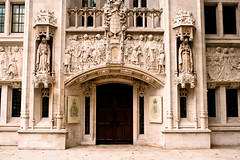 No, not the Irish Supreme Court, but the new UK Supreme Court. There’s quite a lot of coverage in the UK media and blawgopshere today about the new Court at the apex of UK’s judicial system, which opens for business today, on time and on budget, in a refurbished former criminal court, after a difficult gestation. David Pannick argues in the Times today that, however unhappy its origins, the opening of a new Supreme Court is an important commitment to the rule of law. Much of the media interest turns on the fact that the Court will be televised. For example, one of the pieces in the Times is headlined that TV coverage means justice really will be seen to be done:
No, not the Irish Supreme Court, but the new UK Supreme Court. There’s quite a lot of coverage in the UK media and blawgopshere today about the new Court at the apex of UK’s judicial system, which opens for business today, on time and on budget, in a refurbished former criminal court, after a difficult gestation. David Pannick argues in the Times today that, however unhappy its origins, the opening of a new Supreme Court is an important commitment to the rule of law. Much of the media interest turns on the fact that the Court will be televised. For example, one of the pieces in the Times is headlined that TV coverage means justice really will be seen to be done:
The reform has taken a number of steps over 20 years: a Bar Council report chaired by Jonathan Caplan, QC, in 1989, the filming of parts of the Shipman inquiry and the Hutton inquiry and the 2004 pilot project in the Court of Appeal all moved the issue of cameras in court forward. … The footage will be filmed and recorded by the court and made available by a feed to broadcasters, … [and] can be used only for news, current affairs and educational and legal training programmes.
The opening ceremony can be viewed on the Sky News website (update: and is covered by the Times here; I must say I much prefer their new gowns to those now being worn the UK’s other courts). The televising of the Court is one aspect of the range of information technology that make it the UK’s most technologically advanced court. With more publicity is likely to come more interest; the President new Court, Lord Phillips of Worth Matravers, accepts in an interview in today’ Times that it is “inevitable that there will be more interest in who is appointed to the Supreme Court — and I am bound to say that that is a perfectly legitimate state of affairs”. The Court’s Chief Executive, Jenny Rowe, makes a similar point in a podcast interview. Hand in hand with this, many lawyers believe that it will flex its muscles to become more powerful – in the long term, though probably not immediately – than the Law Lords that it replaces. The development has been welcomed by judges in equivalent courts elsewhere.
Most of the articles have a throwaway reference to the judicial activism of the US Supreme Court. However, yet another piece in today’s Times argue that the Court is not an imported US idea but a perfectly English idea, modelled on 18th century British conceptions of free democracy:
it marks the welcome return of an idea that first emerged in Britain in the mid-18th century: the separation of powers. And it was the Americans who stole the idea from us, thanks to the writings of an inquisitive French philosopher … Baron de Montesquieu, …
But, in a move from high theory to low farce, the Court will sit for the first time on Thursday to deal with a relatively minor issue relating to legal costs – its first major appeal hearing follows next week in a case concerning terrorist suspects whose assets have been frozen, though – ironically – that case will not in fact be televised.
The Irish Constitution embodies a strong conception of the separation of powers, where the Supreme Court is constitutionally secure at the top of an independent judicial arm of government. So, when will it follow suit, and televise its proceedings too?
Bonus links: (01 Oct 2009) the ever acerbic Queen’s Counsel cartoon strip is turns its sharp eye on the new Court today; (02 Oct 2009): the Times continues its coverage with an excellent piece: Justices swear themselves in as Supreme Court opens. I’d better not write too much more about the Court for a while, or else I’ll be on the receiving end of an Onion chat about this Supreme Court obsession.
It’s always seemed to me that the motivations behind creating the new British Supreme Court were based on style over substance. Have there ever been any serious suggestions that the Judicial Committee of the House of Lords lacked impartiality because the Law Lords were part of Parliament? I also thought it was somewhat fitting that, in a legal system based on Parliamentary Sovereignty, Britain’s highest court was contained within Parliament.